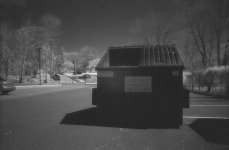This may have nothing to do with IR or with your filter.
I have a Summicron 28mm f2.0 that developed a similar spot in the center of most photos. It was akin to a flare spot at first, but eventually it appeared in nearly every shot, whether the sun was at an oblique angle to the lens surface or not. I even have a shot where I am shooting down at a 45 degree angle towards the ground with the sun to my back, and the spot is there.
I first noticed it in black & white photos as a light haze or fog in the center. Later it I begin to notice it in color photos as a central area of lavender, almost as if the photo had faded slightly and red shifted in the center of the image.
Eventually it was very noticeable. You can see the spot here in this photo from a trip I took to Georgia. Click on the photo for a larger version.
 There are others in that set too
There are others in that set too, though at the time the spot was still subtle enough that I thought it was merely "pilot error".
If your lens has the same problem as my lens, then it has to do with an inferior coating used in some of the 28mm Summicrons. As the coating deteriorates, the spot will worsen and occur with or without the hood, with or without filters.
My lens was repaired by Leica as a defect. They were very courteous but the process was not speedy. It took a year to get my lens completely repaired. The first trip to Solms resulted in the two cemented groups being replaced. The second trip resulted in all the remaining groups being replaced. So I essentially have a new lens now, and for that I am appreciative of Leica's customer service. And (knock on wood) no spot in the center of my photos.
I would run test rolls in every permutation you can come up with. I did B&W and color, hood and no hood, filter and no filter, camera body 1 and camera body 2, each time finding shots that showed evidence of a central dot. I printed out paper copies of the photos and burned a CD with full-sized high resolution scans of the images, and I sent those along with photocopies of all my receipts and warranty information with the lens to Leica USA. Then I called or emailed frequently. Leica's replies were always courteous and helpful, but it just took a long time to go through all the permutations with Solms.
If you have any specific questions, feel free to pm me. Honestly I hope this is not your issue. The 28mm is my favorite lens, and I found the year long wait depressing enough to nearly sell off all my Leica stuff. I am glad now that I did not.



